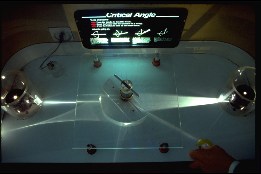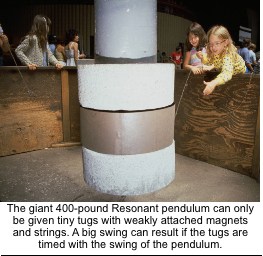 | material, a gadget, or a phenomena that clearly illustrates something we want to show. The Glass Bead Rainbows, the Eye Shimmer Poster, the Walking Beats, the Hi-Q Spring, the Adjustable Plaything and the Shoe Tester are examples of such "found" exhibits. Some exhibits are spin off results from staff discoveries as they work on a completely different exhibit. Such are the exhibits Mirrorly a Window, the Cheshire Cat or the Brine Shrimp Ballet. Sometimes we have to search hard and long and even put the matter aside for a year or so, before we find a technique for showing some particular effect. We tried Ouzo and Pernod in water to show the preferential scattering of blue light by fine particles but the particles gradually coalesced. We had to await a staff member's discovery that the right kind of gelatin would make a good Blue Sky exhibit. The most interesting developments can result when we ask ourselves questions such as, "What is the most basic thing we want to show about nerves?", and then: "How can we best demonstrate that nerves encode the intensity of their stimulation by increasing the frequency of the neural pulses they transmit?" I believe it was Professor Kennedy's neurophysiology laboratory at Stanford that came up with the idea of using a Crayfish Tail to show this effect. | |||
Light is refracted and reflected at Critical Angle. | ||||
| due to the spherical aberration of the wide lens. The other light source produces the narrow "ray" of a beam that it was intended to make. We have added a short 1" diameter Lucite cylinder tied to a string that the visitor can place in the ray to steer the light toward any part of the lens. The visitor can, as is customary, observe the path of the light on the white Formica table top below the lens, but the ray also impinges on the white rear wall of the exhibit. One can see the rainbow colors disappear one at a time as each color reaches the critical angle. I have seen similar exhibits in other museums in which the activities allowed the visitors are much more restricted. In one display, the semicircular lens was constrained to rotate only 180°, presumably to insure that the visitor did not miss the total internal reflection effects. I found the constraint maddeningly frustrating. In fact in general, it is important to allow the variables in an exhibit to change enough so that the interesting effects disappear. One learns as much or more about an effect by its disappearance as by its appearance. Many, many visitors ask "Where do the ideas for these exhibits come from?" Our answer is: "From many, many different sources". A good number of the exhibits are adaptations of quite standard laboratory or lecture demonstration equipment. We learn about them from our own museums, research labs and universities and from published reports. Other exhibits originate because, while wandering around town or through our junk drawers, we encounter some | ||||
 | ||||
| When asked "how can we best show that a large resonant response can arise from repeated, properly timed tiny pushes or pulls", | ||||